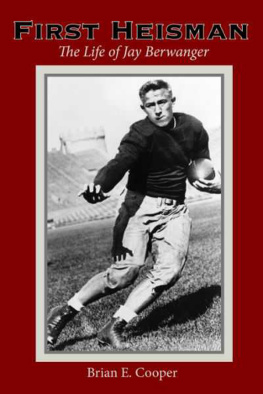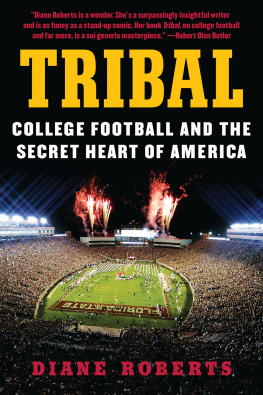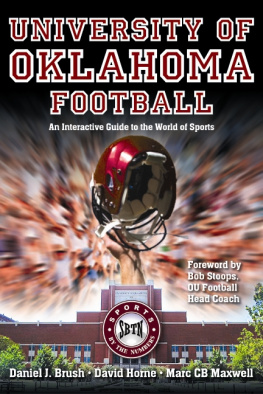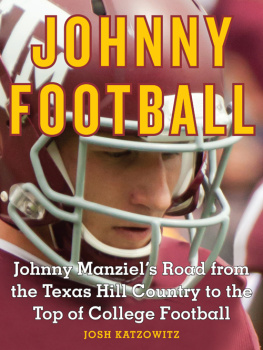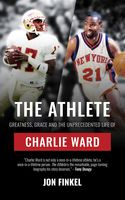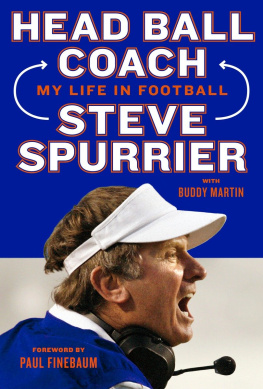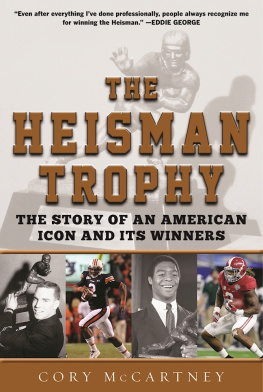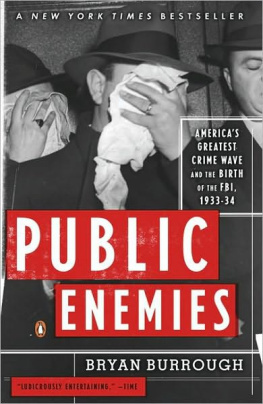FIRST HEISMAN
The Life of Jay Berwanger
ALSO BY BRIAN E. COOPER
McCoy Group: A History of Commitment to the Customer
(McCoy Group, 2012)
Ray Schalk: A Baseball Biography
(McFarland & Company, 2009)
Red Faber: A Biography of the Hall of Fame Spitball Pitcher
(McFarland & Company, 2007)
FIRST HEISMAN
The Life of Jay Berwanger
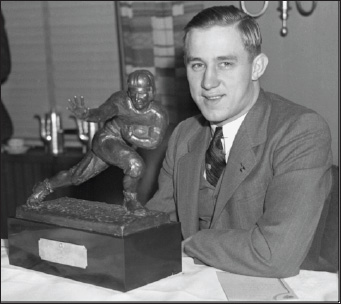
December 10, 1935: The day Jay Berwangers life changed forever.
Brian E. Cooper

CRESTWOOD PUBLISHING
Dubuque, Iowa
Copyright 2014 by Brian E. Cooper
All rights reserved.
Published in the United States by Crestwood Publishing, Dubuque, Iowa.
All rights reserved. No part of this book may be reproduced or transmitted in any manner, electronic or mechanical, including photocopying or recording, or by any information storage and retrieval system, without written permission from the publisher.
Cooper, Brian E., 1954
First Heisman: The Life of Jay Berwanger / Brian E. Cooper
Includes bibliographical references and index.
ISBN-13: 9780988571600
eISBN: 9780988571617
1. Berwanger, Jay, 1914-2002. 2. Football players United States
Biography. 3. University of Chicago.
Manufactured in the United States of America.
Crestwood Publishing
3462 Crestwood Drive
Dubuque, Iowa 52002-5117
www.crestwoodpublishing.com
Distributed by Cardinal Publishers Group
www.cardinalpub.com
First Edition
Front cover image: Special Collections Research Center,
University of Chicago Library.
Title page image: Corbis Images.
Cover and book design and layout: Carmen Goedken.
To my wife, Ann, for her support and patience during this project especially since she doesnt even like football.
CONTENTS
ACKNOWLEDGMENTS
I am humbled by the generosity of the many people who assisted me, in ways large and small, in this endeavor. Some did so in their professional capacities. Others helped as a personal favor to me. However, time and again, folks went the extra yard out of respect for Jay Berwanger and his legacy. Whatever their motivation, I am most grateful.
This biography would be incomplete without the incredible cooperation and support of Jays three children John, Helen, and, especially, Cuyler (Butch). They gave their time (and patience). They shared personal stories. And they loaned photographs, memorabilia, and important documents to help me tell his story with accuracy and insight. In addition, Johns wife, Pat, and Butchs wife, Jackie, also shared their observations and graciously opened their homes to this visitor from Jays hometown.
Among other relatives who provided important assistance were Jays stepdaughter Marianne Gerwig and his nephew Gary Lungwitz, who resides a short pass from Jays boyhood home in Dubuque.
My research included a handful of trips to the Berwangers alma mater, the University of Chicago. I spent dozens of hours in Joseph Regenstein Library coincidentally, built on the site of the original Stagg Field where Daniel Meyers Special Collections Research Center staff and Ray Gadke, head of the microforms area, provided patient and professional assistance.
Additionally, I thank Will Hoyer for agreeing to proofread his father-in- laws manuscript, Tim Manning for proofing pages, and Carmen Goedken for designing the book from front cover to back.
With apologies for any inadvertent omissions, I sincerely thank these individuals and institutions for their help with this biography:
Individuals: Timothy Bachmann; Norma Banas; Ronald Beatty; Charles Benson; Cindy Bertaut; Cuyler Butch Berwanger; Jackie Berwanger; John Berwanger; Patricia Berwanger; Mirdza Berzins; Bradley T. Boyle; Brent Cook; John P. Davey; Elizabeth C. Deegan; Ernest Dix; Jack Dye; Raymond E. Gadke; Michael Gibson; Marianne Gerwig; Carmen Goedken; Archie Griffin; John Haarlow; Michelle Hellmer; Tim Henning; Dave Hilbert; Will Hoyer; Joel Katcoff; John Kuhl; Bud Legg; Gary Lungwitz; John McGlothlen; Tim Manning; Daniel Meyer; Dr. Bruce Montella; Martin Northway; Michelle Oberhoffer; Leonard Paul; Barby Pratt; Bob Quinn; Rudy Riska; Craig Schaefer; Jeff Sciortino; Eli Seamans; Mary Sharp; Robert A. Simpson; Bob Sokol; Kent Stephens; Kim Swift; Helen Berwanger Tierney; Tom Weingartner; Randall F. Weissman; Emory J. Westcott; Rob Whalen; Victor Winnek; Paula Wolfe; Rich Wolfe; Jim Wright; Kathy Young; and Frank Zarnowski.
Institutions and organizations: Camp Highlands for Boys, Sayner, Wisconsin; Carnegie-Stout Public Library, Dubuque, Iowa; Center for Dubuque History; Chicago Public Library; Chicago Tribune; College Football Hall of Fame; Colorado State University Libraries; Cresco (Iowa) Public Library; Davenport (Iowa) Public Library; Dubuque Community School District; Dubuque (Iowa) Senior High School; Fort Dodge (Iowa) Public Library; Freeport (Illinois) Public Library; The Gazette, Cedar Rapids, Iowa; Glogau Photography (and Capitol and Glogau); Hinsdale (Illinois) Golf Club; The Heisman Trophy Trust; Iowa High School Athletic Association; Iowa Historical Society; Jay Berwanger, Incorporated; La Crosse (Wisconsin) Public Library; La Crosse (Wisconsin) Tribune; LaSalle (Illinois) Public Library; Loras College, Dubuque, Iowa; Loyola University, Chicago; Moline (Illinois) High School Booster Club; Oelwein (Iowa) Public Library; University of Chicago; and Washington High School, Cedar Rapids, Iowa.
PREFACE
When Jay Berwanger died in June 2002, obituaries from coast to coast featured the 88-year-olds status as recipient of college footballs first Heisman Trophy. No one could have predicted that story angle in 1935, when Berwanger, more excited that the award came with his first airplane trip than the award itself, accepted a statue from the Downtown Athletic Club, an organization in New York City whose athletic director was former college coach John W. Heisman. After all, there were more prestigious awards at the time, including several All-America teams; the Douglas Fairbanks Award; Liberty Magazines award; and the one Berwanger particularly coveted, the Chicago Tribunes Silver Football, awarded to the most valuable player in the Big Ten Conference. The University of Chicago star won all those awards and more.
At first, I had trouble believing that no one had already written a biography of Jay Berwanger. No author from his native Dubuque, Iowa? Or from Chicago, where in 1930s he won acclaim as the best player in college football? I couldnt find a listing for any such book. When researchers at our local library had the same result, I committed to make Berwanger the subject of my third biography.
Born into a German-American family nearly a century ago, John Jacob Berwanger was the humble son of a Dubuque blacksmith. He lived and played in a different era. There were no youth tackle-football leagues. All high school fields were covered with natural grass, not artificial turf. And Heisman was the name of a coach, not a trophy. Players took the field with leather helmets and no face protection (more about that later). And once they were on the field, they stayed there. The game had no offensive specialists, no defensive specialists and certainly no special teams. In light of the substitution rules of the day, athletes played both ways and thought nothing of it. Berwanger was in the center of that action, not only starring on offense, but also making jarring defensive stops as well as handling, punting, and place-kicking.
After winning honors as Iowas best high school player of 1931, Berwanger accepted an honor scholarship from the University of Chicago, then a member of the Big Ten Conference, whose fading program was coached by the legendary Amos Alonzo Stagg. Berwangers full-tuition scholarship (officially, for citizenship and academics as well as athletics) was worth a grand total of $300 a year. The best college player in the land still had to pay for his room and board.
Next page
